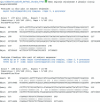BLAST: improvements for better sequence analysis
- PMID: 16845079
- PMCID: PMC1538791
- DOI: 10.1093/nar/gkl164
BLAST: improvements for better sequence analysis
Abstract
Basic local alignment search tool (BLAST) is a sequence similarity search program. The National Center for Biotechnology Information (NCBI) maintains a BLAST server with a home page at http://www.ncbi.nlm.nih.gov/BLAST/. We report here on recent enhancements to the results produced by the BLAST server at the NCBI. These include features to highlight mismatches between similar sequences, show where the query was masked for low-complexity sequence, and integrate information about the database sequences from the NCBI Entrez system into the BLAST display. Changes to how the database sequences are fetched have also improved the speed of the report generator.
Figures



References
-
- Altschul S.F., Gish W., Miller W., Myers E.W., Lipman D.J. Basic local alignment search tool. J. Mol. Biol. 1990;215:403–410. - PubMed
-
- Madden T.L. The BLAST sequence analysis tool. In: McEntyre J., editor. The NCBI Handbook [Internet] Bethesda, MD: National Library of Medicine (US), National Center for Biotechnology Information; 2002.
-
- Schuler G.D., Epstein J.A., Ohkawa H., Kans J.A. Entrez: molecular biology database and retrieval system. Meth. Enzymol. 1996;266:141–162. - PubMed
Publication types
MeSH terms
Grants and funding
LinkOut - more resources
Full Text Sources
Other Literature Sources
Research Materials

